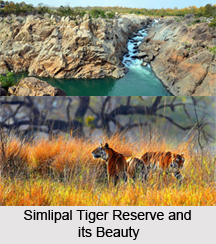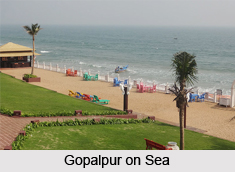 Nature Tourism in Odisha is just like a peaceful swim enjoying the warmth of the sun to a tourist. Visiting the famous Puri beach here is also a priority. In the west end of town, along Marine Parade, the atmosphere is more akin to a British Victorian holiday resort, with a row of hotels looking across the parade to the beach. This stretch is very much the domain of the domestic tourist industry. It is an agreeable place to stroll and becomes highly animated after sunset when the nightly souvenir market gets going. Local fishermen patrol the beach as lifeguards; recognizable by their triangular straw hats and dhotis, they wade with their punters into the surf and literally hold their hands to keep them on their feet.
Nature Tourism in Odisha is just like a peaceful swim enjoying the warmth of the sun to a tourist. Visiting the famous Puri beach here is also a priority. In the west end of town, along Marine Parade, the atmosphere is more akin to a British Victorian holiday resort, with a row of hotels looking across the parade to the beach. This stretch is very much the domain of the domestic tourist industry. It is an agreeable place to stroll and becomes highly animated after sunset when the nightly souvenir market gets going. Local fishermen patrol the beach as lifeguards; recognizable by their triangular straw hats and dhotis, they wade with their punters into the surf and literally hold their hands to keep them on their feet.
Konark Beach
Konark has its own beach near the Konark Temple and is 3 km down the Puri road. It was once picturesque but remains thoroughly windswept and forlorn following the impact of the 1999 cyclone in October. Although far from ideal for swimming or sunbathing, it is still a good place to wander in the evening or watch the local fishing fleet at work.
Forest and Wildlife in Odisha
The wilderness of Odisha is equally interesting. The virgin forests and the thickly wooded slopes and ridges of the Eastern Ghats Mountain Range in India are a thrill to explore. West of Baripada National Park, the landscape suddenly changes from simple plains to the mixed deciduous forests, perennial streams and glades of savannah grasslands draped around its flanks have allowed for an uncommonly rich diversity of flora and fauna. Simlipal Tiger Reserve deserves to be one of eastern India`s major attractions. The reserve boasts of tigers, leopards, sloth bears, sambar and spotted deer, barking deer, gaur, rhesus and langurs. The evening walks near the forest rest houses or a camping in the Simlipal Tiger Reserve might yield sightings of mongoose, ratel badgers, porcupines, civets, jungle cats, foxes and jackals. The herds of wild elephant are also common and the park`s pools and lakes also support marsh crocodiles, pythons, fishing cars and monitor lizards near the water. There are 231 species of birds here too, including colourful trogons, barbets, hornbills, thrushes, orioles, woodpeckers, parakeets, bee-eaters, spurfowl and jungle fowl. The landscape itself is equally rich, with a backdrop of beautiful granite hills, and a tranquil and pristine old-growth Sal forest. No less than 1076 species of plants have been recorded here, including an impressive 87 different varieties of orchid. The park remains open for visitors from November to mid-June.  The tours are allowed between 6am till 12pm. A special wildlife reserve was set up to protect the giant turtles at the personal behest of Indira Gandhi. Today, the Bhitarakanika Sanctuary on Gahirmatha Beach, 130km northeast of Bhubaneswar, is a safe haven for the creatures. Weeks before the big three or four day invasion, coastguards monitor the shoreline and armed rangers ensure that poachers are kept at bay. For wildlife enthusiasts it is a field day.
The tours are allowed between 6am till 12pm. A special wildlife reserve was set up to protect the giant turtles at the personal behest of Indira Gandhi. Today, the Bhitarakanika Sanctuary on Gahirmatha Beach, 130km northeast of Bhubaneswar, is a safe haven for the creatures. Weeks before the big three or four day invasion, coastguards monitor the shoreline and armed rangers ensure that poachers are kept at bay. For wildlife enthusiasts it is a field day.
Chilka Lake
Chilka Lake and Chilka Wildlife Sanctuary is Asia`s largest lagoon, could easily be mistaken for the sea. From its mud-fringed foreshore one can barely make out the narrow strip of marshy islands and sand-flats that separate the 1100 square kilometre expanse of brackish water from the Bay of Bengal. A variety of birds, from flamingos, pelicans and painted storks to fish eagles, ospreys and kites can be seen here. Many of these are migratory birds from Siberia, Iran and the Himalayas. Chilka is also one of the few places in India where the Irrawady dolphin can be seen. The best way to see the lake and the birds is by a boat trip. Most of the birds head to Nalabana Bird Sanctuary from here.
Nandan Kanan Zoological Park
Nandan Kanan is a zoo, botanical garden and sanctuary will be atreat if one pays a ride from Puri. It is located at a distance of around 20 kilometres from Bhubaneswar, the state capital. The main attraction of this zoo is the white tiger. In addition to these there are threatened species of Asiatic Lions, macaque, crocodiles, mouse deer, pangolin and various other wild species and birds. 
Gopalpur On Sea
Gopalpur, formerly the ancient port of Paloura, must have been a swinging place. a visit here will enable the travellers to undiscovered beach paradise, and the armies of industrious fishermen (katias) hauling in hand nets on Gopalpur`s endless empty shoreline, dressed in traditional pointy straw bonnets. Moreover for those who are looking forward to unwind and enjoy the warm sea breezes, this is as appealing a place as any. Since it is tucked away from the usual beach crowd it is truly the right place to spend the leisurely hours. This tourist place can be accessed through the town of Berhampur, which lies on the main coastal highway and train line. From Berhampur, frequent minibuses and jeeps depart from the central bus stand for the 16-kilometer trip.
Rambha and Barkul
Every year around February and March, a strip of beach at the end of Odisha central river delta witnesses one of the world`s most extraordinary natural spectacles. This place is known as Rambha and Barkul, which is not very far from Gopalpur Beach. Having swum right across the Pacific and Indian oceans, an average 200,000 female Olive Ridley marine turtles crawl onto the sand; each looks for a safe spot, then sets about digging a hole with its hind flippers in which to lay its annual batch of eggs. Twenty minutes later, after a quick breather, they are off again into the surf to begin the journey back to their mating grounds on the other side of the world.
Related Articles
Odisha
Tourism in Odisha
Temples of Odisha
Crafts of Odisha
Beaches of Odisha
Wildlife Sanctuaries Of Orissa
Sunabeda Wildlife Sanctuary



















